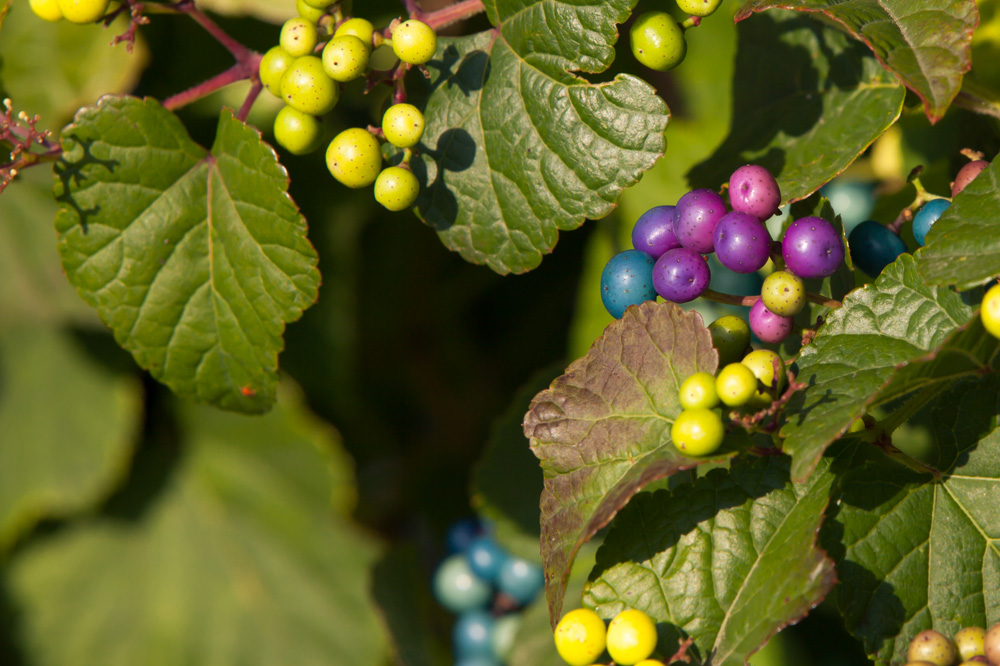Ampelopsis brevipedunculata
Common Name:
Porcelain Berry

General Information:
Once classified as Hedera, an ivy, and then as Vitis, a vine, the genus Ampelopsis was created in 1803. Nobody cared. In 1887, botanists finally took note when the genus was further divided into Ampelopsis and Parthenocissus over some small variations in structure. The end result is that there are few common plants that fall into this genus, and we have two almost unspellable names to remember.
The choice for bonsai is Ampelopsis brevipedunculata, the wild grape or porcelain berry, although the Samsons recommend the genus in general. A. brevipedunculata is a lovely creeping plant with porcelain blue berries.
Lighting:
Likes lots of light, especially the variegated forms.
Temperature:
Can be grown as an indoor bonsai. The Samsons recommend that it never be exposed to temperatures under 54F. However, the company that sold me my Ampelopsis brevipedunculata claims that it should be hardy in zones 6-9, and those who posted indicated that their porcelain berries survived temperatures of 20F and below. Ampelopsis should have a dormant period with leaf loss.
Watering:
Variable according to the growth of the plant. In winter, will need little water, but in summer, it will drink, drink drink!
Feeding:
The Samsons recommend slow-acting organic fertilizer in spring and autumn. I’ve been using Pokon Bonsai Food once monthly, and it seems just fine. Heavy phosphorus feeding in autumn may help to prevent winter die back.
Pruning and wiring:
In a relatively short time, Ampelopsis will form a gnarled, woody trunk. It is very fast growing, and a natural creeper. Styling it as anything other than weeping or cascade styles would be a challenge, to say the least! It is easiest to develop a thick trunk and a few nice branches, and then allow new growth to extend each season. (It may be necessary to prune die back, in any case) To keep the tree neatly styled, wait until 3-5 “eyes” have developed, then prune to 1-2 “eyes” as necessary throughout the growing season. It can be wired during the spring and summer, but wiring should be used sparingly and limited to trunk and major branches. Ampelopsis can be leaf-pruned in late spring or early summer to promote leaf reduction. The plant may flower several times during the season. Murata recommends that fruit from early flowers be removed, as it tends to have an unattractive dirty white colour, and dead-heading will promote the appearance of later flowers. Flowers from late in the season produce the characteristically lovely blue berries.
Propagation:
From softwood cuttings in early spring, or by simple layering in April-May. The plant may also be grown from seeds collected from the berries, which must be cold treated and sown in spring.
Repotting:
Every second year in April. Depending on rate of growth, roots may be pruned by up to half. Use basic soil mix, perhaps a bit heavy on the organic components.
Pests and diseases:
Scale, mildew, black rot. The leaves are very susceptible to insect damage; unfortunately, the leaves are also quite sensitive to pesticide when sprayed. A systemic applied early in the season may be the best solution. Trailing branches often die back in the winter.
Some species suitable for bonsai:
Ampelopsis brevipedunculata - porcelain berry.
Ampelopsis brevipedunculata ‘Elegans’ - a stunning variety. Magenta stems contrast with green and cream colored leaves and porcelain blue berries. Zones 6-9.
Bibliography:
Murata’s “Four Seasons of Bonsai”
Samsons’ “Creative Art of Bonsai”
Species information from Coats’ “Garden Shrubs and Their Histories.”
Compiled by Sabrina Caine
